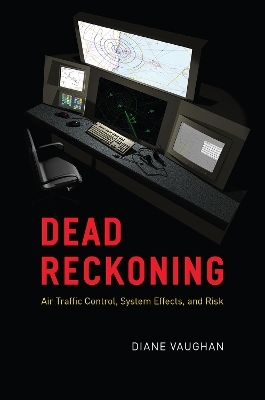
Dead Reckoning
University of Chicago Press (Verlag)
978-0-226-82657-8 (ISBN)
When two airplanes were flown into the World Trade Center towers on September 11, 2001, Americans watched in uncomprehending shock as first responders struggled to react to the situation on the ground. Congruently, another remarkable and heroic feat was taking place in the air: more than six hundred and fifty air traffic control facilities across the country coordinated their efforts to ground four thousand flights in just two hours—an achievement all the more impressive considering the unprecedented nature of the task.
In Dead Reckoning, Diane Vaughan explores the complex work of air traffic controllers, work that is built upon a close relationship between human organizational systems and technology and is remarkably safe given the high level of risk. Vaughan observed the distinct skill sets of air traffic controllers and the ways their workplaces changed to adapt to technological developments and public and political pressures. She chronicles the ways these forces affected their jobs, from their relationships with one another and the layouts of their workspace to their understanding of their job and its place in society. The result is a nuanced and engaging look at an essential role that demands great coordination, collaboration, and focus—a role that technology will likely never be able to replace. Even as the book conveys warnings about complex systems and the liabilities of technological and organizational innovation, it shows the kinds of problem-solving solutions that evolved over time and the importance of people.
Diane Vaughan is professor of sociology and international and public affairs at Columbia University. She is the author of many books including The Challenger Launch Decision: Risky Technology, Culture, and Deviance at NASA, also published by the University of Chicago Press.
List of Figures and Tables
Part I: Beginnings
Chapter 1. Dead Reckoning
Why Air Traffic Control?
Introduction to the System: “A Monkey Could Do This Job”
System Effects on the Project
On Time and Discovery: Historical Ethnography and Socio-technical System History
The Architecture of This Book
Chapter 2. History as Cause: System Emergence, System Effects
A Formation Story
Precedent and Innovation: Boundaries and Boundary Work
The Age of Innovators: The Diffusion of Ideas, Networks, and Infrastructure Formation, 1880–1920
The Age of Organization: Controllers, Technologies, and Boundaries, Ground and Sky, 1920–1950
The Jet Age: Congestion, Technological Lag, and PATCO, 1950–1980
The Age of Conflict, Decline, and Repair: The Strike, NATCA, and Technological Glitches, 1980–2000
Dead Reckoning at the Turn of the Century: History, Boundaries, and Turf Wars in the Sky, 2000–2001
Part II: Producing Controllers
Chapter 3. From Skill Acquisition to Expertise
The Academy: The Screen, the Game, and Survival of the Fittest
The Facility: The Apprentice and the Trainer
The Subtleties of the Craft: Dead Reckoning
Chapter 4. Embodiment: The Social Shaping of Controllers
Carryover into Everyday Life
Fundamental Change: Becoming a Type A Personality
A Cultural System of Knowledge: Expertise, Embodiment, and Ethnocognition
Part III: Boundary Work: Airspace, Place, and Dead Reckoning
System Effects: Culture, Ethnocognition, and Distributed Cognition
Chapter 5. Boston Center and Bedford Tower
Boston Center
Bedford Tower
Chapter 6. The Terminal: Boston TRACON and Boston Tower
The TRACON: Boston Terminal Radar Approach Control
Boston Tower
The Terminal: Boston TRACON and Tower
Part IV: Emotional Labor, Emotion Work
Chapter 7. Mistake and Error: Emotional Labor
Close Calls
Having a Deal
Space, Place, and Boundaries: When Is a Deal Not a Deal?
Mistake and Error as System Effects: Crossing the Boundaries of Time and Social Space
Chapter 8. Risk and Stress: Emotion Work
Losing Control: Stress-Producing Conditions
The Social and Cultural Transformation of Risky Work
Culture, Cognition, and the Normalization of Risk and Stress
The Individual, the Group, and Cultural Devices
Part V: “That Little Frisson of Terror”
Chapter 9. September 11
Boston Center
The Command Center
Boston Center
The TRACON
Boston Tower
Bedford Tower
The Attacks: System Response and System Effects
Chapter 10. The War on Terror: Policing the Sky
Changing Boundaries: Restrictions, Translation, and Local Coordination
Police Work, Emotion Work
A Fragile Stability: 2002
The War on Terror: System Response and System Effects
Chapter 11. Symbolic Boundaries: Distinction, Occupational Community, and Moral Work
Formal Structure and Occupational Community
Status and Moral Work
Maintaining Moral Boundaries
Part VI: System Effects, Boundary Work, and Risk
Boundary Work as Power Work
The Intersection of Two Trajectories: Implementation, Budget Battles, Shutdowns, and Failures
The Liabilities of Technological and Organizational Innovation
Chapter 12. The Age of Automation: 2002–Present
Boston Tower and Boston TRACON
Boston Tower
Boston TRACON
Chapter 13. Continuities, Change, and Persistence
System Effects, Resilience, and Agency
Dead Reckoning: Coordinating Action and Anticipating Futures in Complex Organizational Systems
Acknowledgments
Notes
Bibliography
Index
| Erscheinungsdatum | 07.12.2022 |
|---|---|
| Zusatzinfo | 16 halftones |
| Sprache | englisch |
| Maße | 152 x 229 mm |
| Gewicht | 934 g |
| Themenwelt | Technik ► Fahrzeugbau / Schiffbau |
| Technik ► Luft- / Raumfahrttechnik | |
| ISBN-10 | 0-226-82657-0 / 0226826570 |
| ISBN-13 | 978-0-226-82657-8 / 9780226826578 |
| Zustand | Neuware |
| Haben Sie eine Frage zum Produkt? |
aus dem Bereich


